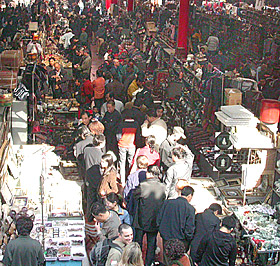Other members of the cadre* have written enough that if I continued my ramble in the manner I intended, I fear reading would get tedious--though reading my longwinded rants probably is anyway. For further explanation, wait till I publish the collected essays of this trip in "Around the World In Eighty-One Days: Another Shamelessly Titled Travel Book," which should hit book shelves within the next two years. (In my dreams. No, not literally. I'll spare you the pain of hearing about my dreams as well, dear reader.)
I'll highlight the amusing parts that star me.
1) My horse.
In the morning after out first night, I am put on a horse and told, through gesture and what was either Mongolian or someone just laughing at me, how to steer the monstrosity I had the pleasure of sitting on. I use monstrosity not to describe size, but to convey a meaning of "monster like," specifically referring to the beast's temperament.
In short, this horse wanted anything but for me to be on its back.
It told me this by walking straight to a clothes line with the intent to knock me off. Our kind host raised the clothes line in time, but this set the tone for the rest of my brief time on this animal. It would walk a few steps away from the ger and then stop, walk backwards, turn in circles, or just do anything else it damn-well-pleased that was not what I was trying to tell it to do. In frustration, the herder attached the horse to the cart and lead it that way.
The horse, god bless his little horsey soul, decided h e was ready to walk on his own and listened to me for a bit. We got to ride without being tethered to a cart like two small, disobedient children. He was slow, but he listened.
Then it stopped again.
Yelling, kicking, and even throwing rocks (the herder, not me) could not get the beast to move. So the herder attached it back to the cart. It didn't want to move and instead reared up backwards and then fell down. Or should I say threw itself down, because it did just that.
Thus, I got off the beast and didn't ride for the rest of the trip.
2) Boltzig
When one enters a ger, they are given milk tea and boltzig. Boltzig, much like the milk tea, varies ger to ger. Some is soft, some is warm, some is hard, some is sweet, some is salty, some is greasy, and some doesn't taste like practically anything. Our standard entering of a new ger went like this:
Step 1, say hello.
Step 2, be sat down.
Step 3, have someone mime being cold to us and then say "Huten!"
Step 4, be given a bowl of milk tea.
Step 5, have a container of boltzig be placed in front of us.
Step 6, try the boltzig out of manner's Allison instilled in us.
Step 7, not eat anymore boltzig.
Step 8, have a host come up and eat a piece before gesturing that we do the same.
Step 9, eat more boltzig.
Whenever someone new walked in the ger, someone from the host's side, we would repeat steps 1, 3, 8, and 9. Occasionally this would be broken up by step 5(b), "refill container with more boltzig."
We ate a lot of boltzig.
They're good, but if I never eat it again for the rest of my life, I won't bemoan the lack of boltzig in my future.
3) Huten!
I'm probably "romanizing" this wrong, but, quite frankly, I gave up trying to romanize anything correctly when I first typed "suu te tse" and found myself disgusted with how it looked. ("Suu" looks like "cyy" in cyrillic.)
So, huten is a good way to describe the trip and we had a crash course in how the country deals with the weather--something Allison had warned us about. The weather felt kind of like my beloved Pgh in March: colder than I wanted it to be at any given point in time. Mongolians deal with the weather the way most of America does, by trying to push it as far in the opposite direction as possible and hoping that it neutralizes somewhere. Inside the gers was nice and warm when we first entered. Before too much longer it got a little warmer than I'd like. Then the sweatshirt came off and it was good again. Eventually I'd just be sweating, run outside to cool down, go "Oh,
Amber has a good anecdote about how hot her sleeping back was when she and I shared a bed in one of the gers.
Our hosts were extremely accommodating throughout my adjustment to the temperature management systems. (By the final day I was okay with it!) They took immensely good care of us. I recommend Ger-to-Ger for all your traveling about the Mongolian countryside need s.
*For explanation of my overly abundant usage of the word "cadre," see "Incarnation Day," by Walter Jon Williams.
















